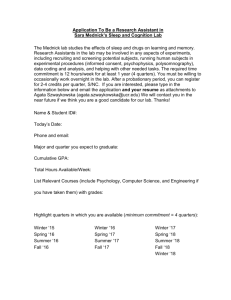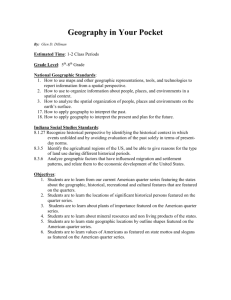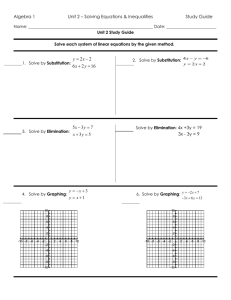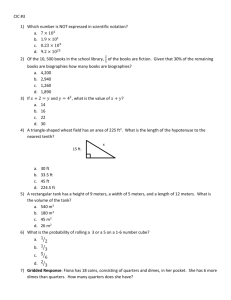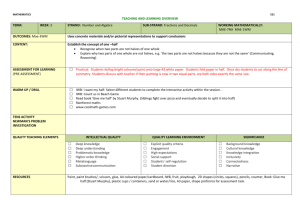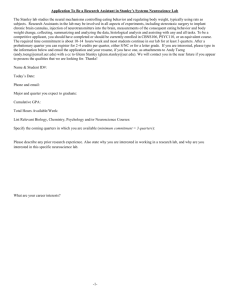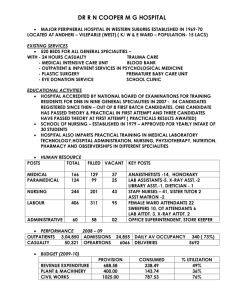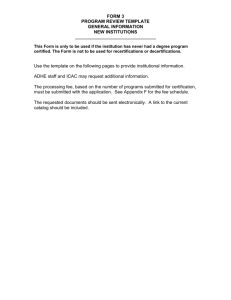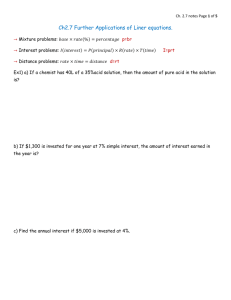Year 2 Teaching Sequence xxx
advertisement
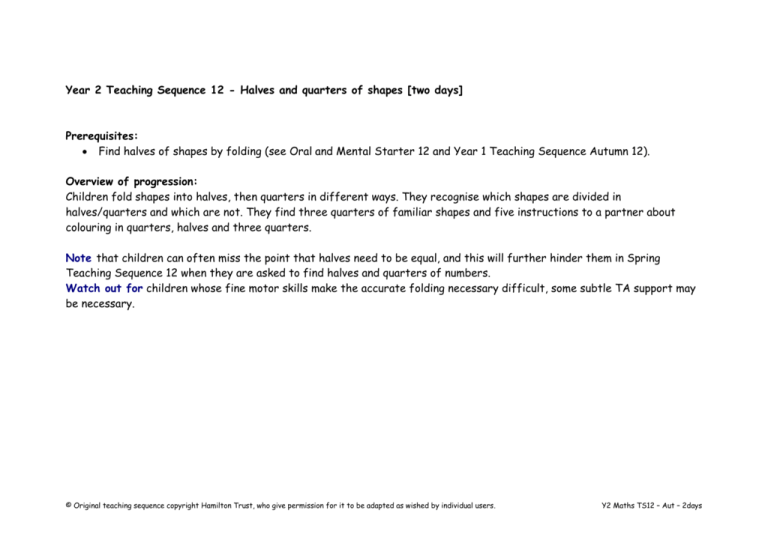
Year 2 Teaching Sequence 12 - Halves and quarters of shapes [two days] Prerequisites: Find halves of shapes by folding (see Oral and Mental Starter 12 and Year 1 Teaching Sequence Autumn 12). Overview of progression: Children fold shapes into halves, then quarters in different ways. They recognise which shapes are divided in halves/quarters and which are not. They find three quarters of familiar shapes and five instructions to a partner about colouring in quarters, halves and three quarters. Note that children can often miss the point that halves need to be equal, and this will further hinder them in Spring Teaching Sequence 12 when they are asked to find halves and quarters of numbers. Watch out for children whose fine motor skills make the accurate folding necessary difficult, some subtle TA support may be necessary. © Original teaching sequence copyright Hamilton Trust, who give permission for it to be adapted as wished by individual users. Y2 Maths TS12 – Aut – 2days Objectives: Find halves and quarters of shapes by folding; Recognise which shapes are divided in halves/quarters and which are not. Whole class Group activities Paired/indiv practice Show chn a piece of A4 paper, and fold it in half, and then open it out again. What have I done? What do we call each part? Can you remember how we write them? Write ½ on each part. How many halves make a whole? Fold an identical piece of paper into quarters, by folding it in half and half again. I’ve folded this piece of paper into four equal parts we call these quarters. Write ¼ on each section. How many quarters make a whole? How many quarters make one half? Give each pair of chn a square and a circle from Activity sheet (see resources) and ask them to fold their shape in half and then half again. Explain that folding it in half and half again is a good way to make sure each part is the same size. Discuss how the quarters of the circles and the squares look different. Show chn a square folded in half along a diagonal. Is this shape folded in half? How do you know? Fold again to show quarters. Ask if chn can think of another way to fold the square into quarters, such as the way below. Group of 4-5 children Fold one of the shapes from Activity sheet (see resources) in half, and challenge chn to try and fold their in a different way to yours. Rpt with each shape, and then rpt but this time folding them into quarters. Easier: It may be that some chn need more practice in folding into halves before moving onto just a few examples of folding into quarters. Harder: Move onto quarters more quickly. Ask chn to ‘tick’ and ‘cross’ the shapes on Activity sheet (see resources) according to whether they are correctly divided into halves or quarters. They can use a red pencil to correct them! Harder: They could work out if the person got more than half right! © Original teaching sequence copyright Hamilton Trust, who give permission for it to be adapted as wished by individual users. Resources A4 paper Activity sheet - square and circle Activity sheet - different shapes to cut out and fold, copy onto A3 Activity sheet - shapes divided into two or four parts Go Maths PCM 32 Y2 Maths TS12 – Aut – 2days Fold an A4 piece of paper into two parts, but not equally and open it out. Has this piece of paper been folded in half? There are two parts. Discuss how both parts need to be equal. If I was to tear this piece of paper along this fold and share it between two chn, it wouldn’t be fair; one would have a bigger piece than the other. Rpt folding into four unequal parts. Draw a square, and divide it into quarters. Colour in one quarter at a time, until you have three quarters shaded, each time asking how much is coloured in? Record ¾ on the board. Ask chn to draw a square on their whiteboard and to colour in ¾ in a different way to yours. Show a variety of chn’s boards. Rpt with a rectangle and a circle. Group of 4-6 children Give each pair a square piece of appear. Fold it into quarters, and colour half red. Try to make it look different from the others (e.g. top, bottom, left, right rectangles, or triangles). Share their results and discuss how the halves look different but are all half of the square. Rpt with another square, this time asking chn to colour in one quarter. How can you divide your paper into quarters? Rpt this time asking chn to colour three Chn each ‘secretly’ colour each quarter of the first square on Activity sheet (see resources), using only three colours. They then describe how they have coloured it to their pattern, who tries to colour the second square to match their partners. They then swap, and repeat with the next pair of squares. Easier: Use Activity sheet (see resources) instead. © Original teaching sequence copyright Hamilton Trust, who give permission for it to be adapted as wished by individual users. Activity sheet - squares divided into quarters Go Maths PCM 104 Y2 Maths TS12 – Aut – 2days quarters. How can you work out how much to colour? Easier: Show them an example of each before they colour their own in. © Original teaching sequence copyright Hamilton Trust, who give permission for it to be adapted as wished by individual users. Y2 Maths TS12 – Aut – 2days
